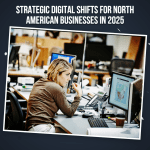Executive Overview
Artificial intelligence has moved from theoretical promise to operational reality. In 2025 organisations of every size now integrate machine learning, natural language processing, and computer vision into their content pipelines. The objective is singular: deliver timely, relevant, and high quality digital assets that strengthen brand authority, improve search visibility, and convert audience attention into measurable growth. Recent studies by North American trade associations indicate that more than forty five percent of small and medium enterprises have piloted at least one AI driven content tool during the past twelve months, while enterprise adoption exceeds seventy percent. This article examines the strategic factors driving implementation, the technical capabilities available today, and the governance principles required to ensure long term value creation.
Market Forces Behind Accelerated Adoption
Demand for Always-On Engagement
Customer expectations have evolved toward continuous interaction across websites, social platforms, email, and emerging channels such as connected television. Manual editorial processes cannot reliably meet the cadence required to sustain competitiveness without inflating operational costs. AI assisted creation addresses this imbalance by automating repetitive drafting, editing, and multimedia production.
Intensifying Competitive Landscape
Barriers to entry in most digital markets are lower than ever. Competitors deploy aggressive content schedules to occupy search engine real estate and social timelines. Firms that fail to match volume and relevance risk erosion of market share and brand credibility.
Advancements in Generative Models
Large language models trained on diverse corpora now generate coherent prose, code snippets, and marketing copy. Parallel progress in diffusion and transformer techniques enables the rapid generation of high resolution imagery, video snippets, and audio. These advancements provide a holistic toolkit for integrated campaigns.
Economic Efficiency Mandates
Shareholders demand lean operations. Subscription based AI platforms priced on a monthly or usage tier model replace multiple freelance or in house roles, freeing budget for strategic initiatives such as data infrastructure or product innovation.
Core Capabilities Reshaping Content Operations
Automated Ideation and Drafting
Natural language models interpret concise prompts to produce article outlines, headline variations, and full length drafts. Marketing strategists can iterate on tone, length, and keyword focus in near real time, compressing cycles that previously required several days.
Multimodal Asset Creation
Text to image and text to video systems allow designers to prototype banners, thumbnails, and short form animations without initial sketches. The creative team reserves its expertise for brand alignment, visual refinement, and compliance checks.
Personalisation at Scale
Machine learning algorithms analyse user behaviour, geographic data, and historical engagement to tailor headlines, calls to action, and product recommendations. This granular relevance increases click through rates and reduces bounce metrics across owned media channels.
Semantic Optimisation for Search
AI driven optimisation layers evaluate keyword density, readability indices, meta descriptions, and structured data. Continuous learning ensures alignment with evolving search engine guidelines, enhancing organic visibility and domain authority.
Performance Analytics and Feedback
Predictive models ingest engagement data across channels, isolating variables that drive conversions. Insights feed directly into subsequent briefing prompts, establishing an adaptive loop that improves precision over time.
Operational Impact for Organisational Stakeholders
| Stakeholder | Challenge | AI Enabled Resolution |
| Chief Marketing Officer | Sustaining content velocity while protecting brand integrity | Automated drafting with embedded style guides ensures consistency and speed |
| Content Strategist | Identifying topics that resonate with segmented audiences | Predictive topic modelling highlights emerging themes and seasonal interest spikes |
| Creative Director | Balancing design workload with rapid iteration cycles | Generative imagery tools deliver initial concepts within minutes |
| Compliance Officer | Monitoring regulatory adherence across distributed teams | Rule based validation scans flag potential intellectual property or privacy violations |
Governance, Risk, and Ethical Considerations
Transparency and Disclosure
Regulatory bodies in Canada and the United States increasingly expect clear declarations when AI contributes to publicly facing materials. Organisations should adopt policy language disclosing the extent of automation in line with jurisdictional guidance.
Data Privacy
Input prompts frequently contain proprietary information. Selecting vendors that offer end to end encryption, restricted data retention, and contractual assurances regarding model training is essential to safeguard intellectual capital.
Bias Mitigation
Training data may reflect historical socio cultural biases. Firms must perform periodic audits, incorporating representative datasets that counteract skew and engaging third party reviewers when appropriate.
Hallucination Control
Large language models can generate statements that appear factual yet lack verifiable sources. A mandatory human review layer, supplemented by citation verification tools, remains critical before publication.
Financial Modelling and Return on Investment
Cost benefit analyses conducted by independent consultancies demonstrate significant savings over traditional production frameworks. Consider a mid market B2B software company producing eight thought leadership articles and twenty four social graphics per month:
- Traditional expenditure:
- Freelance writing fees: 6400 CAD
- Graphic design agency: 4800 CAD
- Editorial oversight: 40 internal hours
- Freelance writing fees: 6400 CAD
- AI augmented expenditure:
- Platform subscription: 240 CAD
- Editorial oversight: 16 internal hours
- Platform subscription: 240 CAD
Assuming an internal labour rate of 60 CAD per hour, the monthly reduction exceeds 7000 CAD, which can be reallocated to paid media experimentation or advanced analytics initiatives. Additionally, increased velocity correlates with uplift in qualified leads and organic search impressions, amplifying the compound return.
Future Outlook: 2026 and Beyond
Integration with Real Time Data Streams
Next generation models will interface directly with business intelligence dashboards, allowing content to update dynamically alongside inventory, pricing, or regulatory changes.
Unified Experience Ecosystems
AI will underpin cross channel orchestration, synchronising messaging across web, email, mobile applications, and virtual environments, thereby reinforcing coherent brand narratives.
Specialised Vertical Solutions
Sector specific platforms trained on compliant language and regulatory frameworks—such as health care, finance, or government—will accelerate adoption among risk sensitive industries.
Autonomous Campaign Management
Generative agents equipped with reinforcement learning may soon test creative variations, allocate budget across channels, and adjust bids autonomously, reporting performance metrics to human supervisors.
Conclusion
Artificial intelligence has established itself as a cornerstone of modern digital content strategy. Organisations that integrate AI thoughtfully realise measurable efficiency gains, competitive acceleration, and richer stakeholder engagement. Success depends on robust governance, continuous oversight, and alignment with overarching business objectives. Through disciplined implementation, AI becomes not merely a tool but a strategic asset that positions enterprises for sustained digital leadership in an increasingly demanding marketplace.









